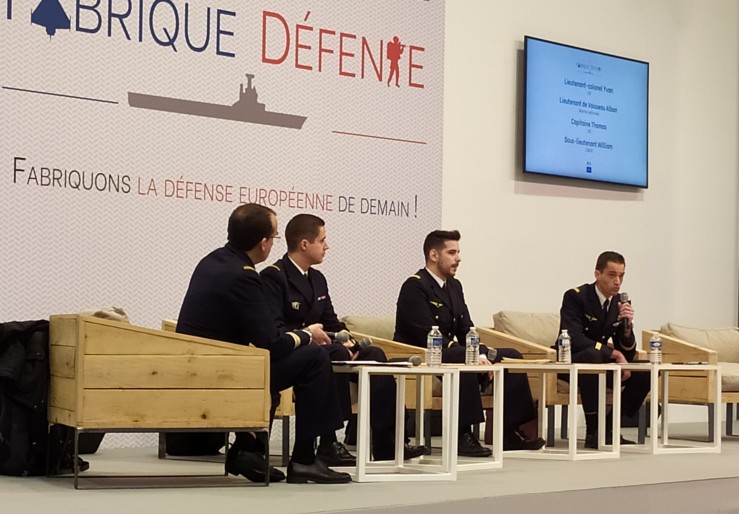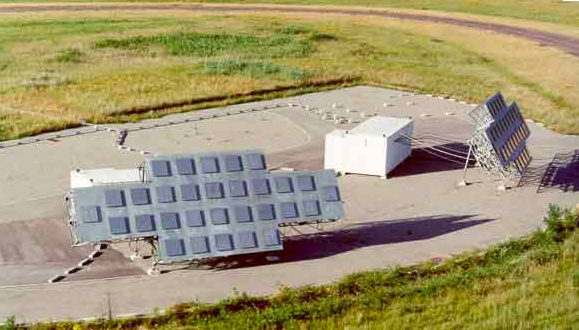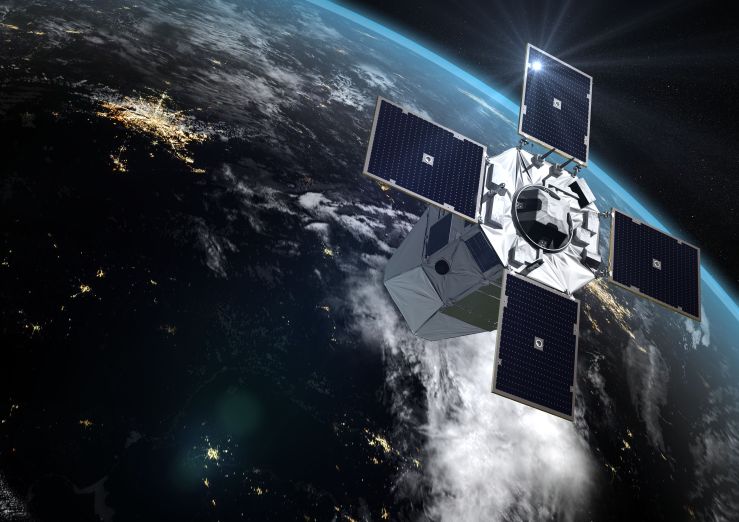The French Ministry of Defense has been opening up in the last few years, in an effort to spur innovation from startups and attract new talent to the armed forces and the defense industry. Lastly, it organized a”Defense Factory” event, which took place in Paris on the 17-18 January 2020. In addition to the stands from various companies and military units, there were a few roundtable with defense officials. One of the most interesting was a roundtable on French military space between a senior officer and three junior officers in different space-related organizations of the ministry.
The panel consisted, from left to right in the picture below, in:
– Lieutenant-Colonel Yvan, from the Joint Space Command (Commandement Interarmées de l’Espace)
– Lieutenant de Vaisseau Alban, from the military intelligence service (Direction du Renseignement Militaire), imagery intelligence section
– Sous-Lieutenant William, from the Space Surveillance Center (Centre Opérationnel de Surveillance Militaire des Objets Spatiaux)
– Capitaine Thomas, from the operational center of the Joint Space Command

It was an Air Force-heavy panel, since they are all from this branch except Lt Alban, who is from the Navy.
The panel was a bit pre-planned, with the senior officer Yvan asking questions that the junior officers had obviously prepared answers to. Still, it was an good way for the French military space community to explain their thinking in a public forum. So here is a summary of the roundtable:
Cl Yvan: What’s new in French military space?
Cpt Thomas:
French military space is undergoing a transformation, with the Joint Space Command being replaced by a Space Command (Commandement de l’Espace) as announced by Minister Parly. In time, the Air Force will become the Air and Space Force, showing the emphasis put on space as an equal domain. Right now, a lot of attention is put on Space Situational Awareness, to detect unfriendly action, such as a close approach by a foreign satellite. This is the first step to being able to defend ourselves, maybe with an offensive space capability.
The image wall of the Joint Space Command, with a very sci-fi look
Cl Yvan: What are the other priorities of this new command?
Lt William:
In the wider picture, there are three main areas of focus for military space:
– Improving in-space capabilities, for instance by reducing the age of space data, in order have more responsive intelligence. Building a resilient Positioning, Navigation and Timing and jam-resilient and stealthy communications are the two other main priorities.
– Improving Space Situational Awareness. The first step is to be able to characterize threats, to know if an action is accidental or hostile. Then, to protect the platforms, by embedding cameras on our satellites so that they can watch their surroundings, or deploying bodyguard satellites around our main assets. Finally, we are working on self-defense and counter-attack concepts.
– Improving the collaboration between the military, the civilians, the industry, and also with allied countries.
Cl Yvan: What kind of operations related to space do we perform?
Cpt Thomas:
From the point of view of the Joint Space Command, we have four different kinds of military operations:
– Support to space capabilities, which includes launch operations and commissioning. This is done in cooperation with the civilians.
– Support to operations on Earth and preparing future satellites
– In-space action, with a capability to defend ourselves in space
– Knowing our domain, which includes Space Situational Awareness, space-related intelligence (“renseignement d’intérêt spatial”) and watching the space environment [think solar flares for instance]. Regarding SSA, we have four different kinds of sensors: optical sensors owned by France [such as TAROT], optical sensors owned by the industry [such as Arianegroup’s Geotracker], the Graves and SATAM radars owned by the military, and the sensors from allied countries.

[For more on French SSA assets see Hearing of the French Joint Commander for Space ]
An interesting debate that often comes up is the distinction between “militarized” versus “arsenalized” space. Our thinking is that space has been militarized since Sputnik was launched in 1957: it is used for Earth Observation and military communications. However, arsenalized space means that conflicts can occurs in space, that the great powers of the world develop offensive means targeting space, that secondary powers like India do too, and that in the future even third-rank nations like North Korea could do it.
Cl Yvan: How is space used by military intelligence?
Lt Alban:
From the point of view of military intelligence, space is very important. Data from space is our first source of non-intrusive intelligence. It is a major contributor to deterrence and to knowing and anticipating, two of the major pillars of our Defense strategy.
Space provides us the capability to collect imagery and signal intelligence, that are fed into a geospatial intelligence pipeline. For us, what is most important about space assets is their availability, their responsiveness and how well their are integrated into operations. For instance, the passes of our satellites are taken into account we we plan operations: the Hamilton cruise missile attack in Syria was designed to exploit satellite passes for a quick Bomb Damage Assessment after the strike.
The new capabilities, namely CSO in the optical spectrum and CERES for signal intelligence, will allow us to speed up the intelligence cycle, and to reduce the delays by increasing the revisit and having the collected data made available faster to intelligence analysts. Besides, Italy, with Cosmos-Skymed second generation, and Germany, with SARah, are bringing new radar capabilities that we exploit.

Regarding the interaction between New Space and intelligence, we think it is a great opportunity to speed up innovation and go after technological breakthroughs. The challenge is becoming the processing of big data, we are confronted with a “wall of data”. We are counting on artificial intelligence to help us automatically detect targets in these large datasets. For us, it is very important to support French New Space companies, so that we can rely on actors that we can trust.
Cl Yvan: What are the threats facing space capabilities?
Cpt Thomas:
Before talking about threats, we must talk about vulnerabilities. We have classified the vulnerabilities that space capabilities havein four groups:
– First, the ground segment, which includes launch, satellite operators, and satellite users
– Of course the satellites themselves
– The communications between satellites and the ground
– Finally the software, both the flight software and the software of the ground segment.
This allows us to consider several kinds of threats:
– Proximity operations by foreign satellites, for instance close inspection to collect intelligence about our assets
– Cyber attacks that can disturb the normal functions of our satellites, take over their control, or even destroy them
– Electronic threats such as jamming, directed energy attacks with lasers, and electromagnetic impulse following a nuclear explosion
– Sabotage of the ground segment
– Offensive robotic operations, with saboteur satellites, or kamikaze satellites
– Ground-to-Space anti-satellite shots
[For more background on the threats satellites face, see Contested Space I: Threats , and for possible ways to counter them see Contested space II: Countermeasures ]

Cl Yvan: How do we avoid dangerous objects?
Lt Williams:
One important aspect of space operations is maneuvering. First, to avoid debris, which have a real risk of creating a chain reaction and making an orbit very dangerous. Second, to avoid hostile approaches. But to maneuver well in space, you have to anticipate a lot, making SSA critical. Future satellites will probably have a larger maneuvering capability.
Cl Yvan:
In conclusion, we can say the keyword of our space policy is ambition. From the standpoint of capabilities first, but also of autonomy. This ambition is based on a political ambition, which flows down into a strong human resources push: the Space Command will see its number of personnel increased five-fold compared to the Joint Space Command. It will be located in Toulouse, the heart of French Space, where there is an Aerospace Valley with startups, major industrial players, and the Space Agency CNES. Finally, the ambition is for our ministry to operate its satellites on its own, without relying on help from CNES.
Audience Q&A
Q: What about Brexit?
A: It is very difficult to see what the impact of it will be.
Q: Regarding SSA, what happens if we lose access to US data? Should we install sensors around the globe?
A: We already have French sensors deployed globally.
Q: Can we manage without space?
A: It is difficult, but we do “days without space” as training exercises. Besides, cutting off all of our space access would be difficult: we have enough redundancy that we can do without any one satellite, and we can rely on international partnerships, especially in communications.
Q: What about Europe?
A: There is a political will to cooperate with other countries, we have foreign personnel in Space Command for instance. We also have bilateral cooperations, with satellites such as Athena-Fidus being operated jointly with Italy.
Q: How to attribute hostile acts?
A: It is very difficult in the cyber domain, especially as it is not the expertise of Space Command. But we do have a cyber cell integrated in the command. But overall, this question is still under study.
Q: Is there an european preference regarding the industry? How to spur innovation from French new space actors?
A: We have set up a spacelab in Toulouse, which is a point of contact between startups and the Space Command.
Q: What is the distance at which a close approach becomes hostile?
A: That is classified. But if there is contact you can say it is hostile. [laughs]
Q: What is the role of civilians in the Space Command?
A: We are paying a lot of attention to attracting women in the command.
Q: What constitutes legitimate self-defense in space?
A: We cannot answer publicly, but we have a member of the commissariat specialized in international law as an adviser to the command to deal with this question.
Q: How to identify unknown satellites?
A: First of all all unknown objects are not satellites, so first we have to tell if they are debris or not.


Reblogged this on The restless technophile.
LikeLike
[…] intelligence satellites can detect communications or radars], and has upwards-looking sensors like radars, They will be reinforced within the ARES space control program, which might also contribute. Air […]
LikeLike